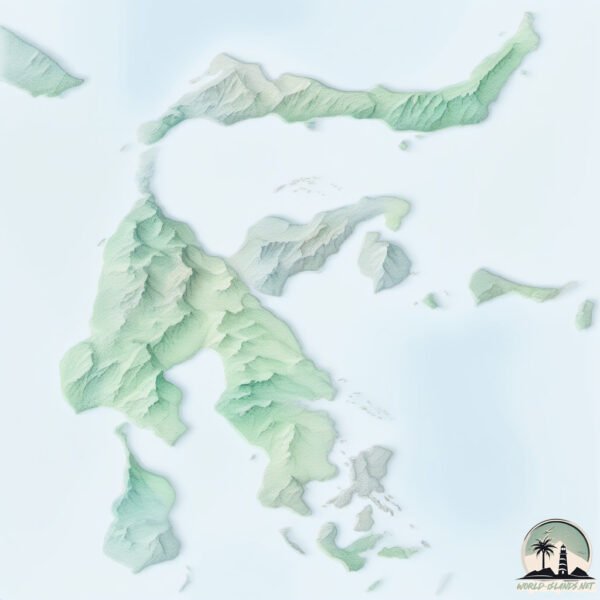Sulawesi

Welcome to Sulawesi, a Tropical island in the Banda Sea, part of the majestic Pacific Ocean. This guide offers a comprehensive overview of what makes Sulawesi unique – from its geography and climate to its population, infrastructure, and beyond. Dive into the details:
- Geography and Size: Explore the island’s size and location.
- Climate and Weather: Weather patterns and temperature.
- Topography and Nature: Uncover the natural wonders of the island.
- Infrastructure and Travelling: Insights on reaching, staying, and making the most of your visit.
- News and Headlines: Latest News.
Geography and size of Sulawesi
Size: 169981 km²
Coastline: 8721 km
Ocean: Pacific Ocean
Sea: Banda Sea
Continent: Asia
Sulawesi is a Colossal Island spanning 169981 km² with a coastline of 8721 km.
Archipel: Greater Sunda Islands – A group of large islands in Southeast Asia, including Borneo, Sumatra, Java, and Sulawesi, known for their rich biodiversity and cultural diversity.
Tectonic Plate: Banda Sea – A small plate in the eastern Indonesian region, known for complex interactions with the Australian and Pacific plates, leading to notable seismic and volcanic activity.
The geographic heart of the island is pinpointed at these coordinates:
Latitude: -2.01246507 / Longitude: 121.11325588
Climate and weather of Sulawesi
Climate Zone: Tropical
Climate Details: Tropical Rainforest Climate
Temperature: Hot
Climate Characteristics: This climate is typified by heavy rainfall throughout the year, high humidity, and consistently high temperatures, leading to lush rainforests and rich biodiversity. Seasonal temperature variations are minimal.
Topography and nature of Sulawesi
Timezone: UTC+08:00
Timezone places: Australia/Perth
Max. Elevation: 3478 m Bulu Rantemario
Mean Elevation: 577 m
Vegetation: Evergreen Broadleaf Forest
Tree Coverage: 67%
The mean elevation is 577 m. Dominating the island’s landscape, the majestic “Bulu Rantemario” rises as the highest peak, soaring to impressive heights. The island is characterized by Mountains: High, steeply elevated landforms. Characterized by both a high maximum elevation (over 500 meters) and a high mean elevation, creating rugged, mountainous terrains on islands.
Dominating Vegetation: Evergreen Broadleaf Forest
Characterized by dense, lush canopies of broadleaf trees that retain their leaves year-round. These forests are typically found in tropical and subtropical regions and are known for their high biodiversity. Sulawesi has a tree cover of 67 %.
Vegetation: 17 vegetation zones – Exceptionally Diverse Island
Islands with more than ten vegetation zones are among the most ecologically rich and varied in the world. These islands are akin to miniature continents, boasting an incredible array of ecosystems. The sheer range of habitats, from high peaks to deep valleys, rainforests to deserts, creates a mosaic of life that is unparalleled. They are crucial for conservation and ecological studies.
Infrastructure and Travelling to Sulawesi
Does the island have a public airport? yes.
Sulawesi has a public and scheduled airport. The following airports are located on this island: Sangia Nibandera Airport, Maleo Airport, Hasanuddin International Airport, Toraja Airport, Bua – Palopo Lagaligo Airport, Mutiara – SIS Al-Jufrie Airport, Andi Jemma Airport, Tanjung Api Airport, Jalaluddin Airport, Sam Ratulangi Airport, Buol Airport, Haluoleo Airport.
Does the island have a major port? yes.
Sulawesi is home to a major port. The following ports are situated on the island: DONGGALA, KENDARI, KOLONODALE.
The mean population of Sulawesi is 117 per km². Sulawesi is Moderately Inhabited. The island belongs to Indonesia.
The name of the island resonates across different cultures and languages. Here is how it is known around the world: Arabic: سولاوسي; German: Sulawesi; Spanish: Célebes; French: Célèbes; Portuguese: Celebes; Russian: Сулавеси; Chinese: 苏拉威西岛
Continuing your journey, Lito Dudepo is the next notable island, situated merely km away.
Quest for the Uncharted World: Sulawesi, Indonesia | Free Documentary



Indonesia is classified as Emerging region: MIKT: Mexico, Indonesia, South Korea, and Turkey – Economies recognized for their development potential and emerging market status. The level of income is Lower middle income.
News – Latest Updates and Headlines from Sulawesi
Stay informed with the most recent news and important headlines from Sulawesi. Here’s a roundup of the latest developments.
- What led to landslides in Indonesia’s Sulawesi island? Know all about topography here - MSNon 22 February 2025
What led to landslides in Indonesia’s Sulawesi island? Know all about topography here MSN
- Alfriston: Critically endangered monkey born at zoo - BBC.comon 16 February 2025
Alfriston: Critically endangered monkey born at zoo BBC.com
- Severe flooding impacts South Sulawesi, Indonesia - Borneo Bulletinon 13 February 2025
Severe flooding impacts South Sulawesi, Indonesia Borneo Bulletin
- Massive flooding strikes South Sulawesi - The Jakarta Poston 12 February 2025
Massive flooding strikes South Sulawesi The Jakarta Post
- Indonesia: Hundreds Evacuated After Severe Flooding Strikes South Sulawesi - MSNon 12 February 2025
Indonesia: Hundreds Evacuated After Severe Flooding Strikes South Sulawesi MSN
- Reconnect Private Island Resort: discover uncharted dive sites in Central Sulawesi - DIVE Magazineon 12 February 2025
Reconnect Private Island Resort: discover uncharted dive sites in Central Sulawesi DIVE Magazine
- South Sulawesi: BNPB provides aid for tornado victims in Luwu - ANTARA Englishon 8 February 2025
South Sulawesi: BNPB provides aid for tornado victims in Luwu ANTARA English
- DD Slter: Where Cancer Fighters Live in West Sulawesi - Dompet Dhuafaon 5 February 2025
DD Slter: Where Cancer Fighters Live in West Sulawesi Dompet Dhuafa
- French Mining Giant Eramet Eyes Investing in South Sulawesi, Papua - Jakartaglobe.idon 5 February 2025
French Mining Giant Eramet Eyes Investing in South Sulawesi, Papua Jakartaglobe.id
- Indonesia says Eramet exploring new mining areas in South Sulawesi, Papua - MINING.comon 4 February 2025
Indonesia says Eramet exploring new mining areas in South Sulawesi, Papua MINING.com
Social Media Posts about Sulawesi
Please note: The data used here has been primarily extracted from satellite readings. Deviations from exact values may occur, particularly regarding the height of elevations and population density. Land area and coastline measurements refer to average values at mean high tide.
